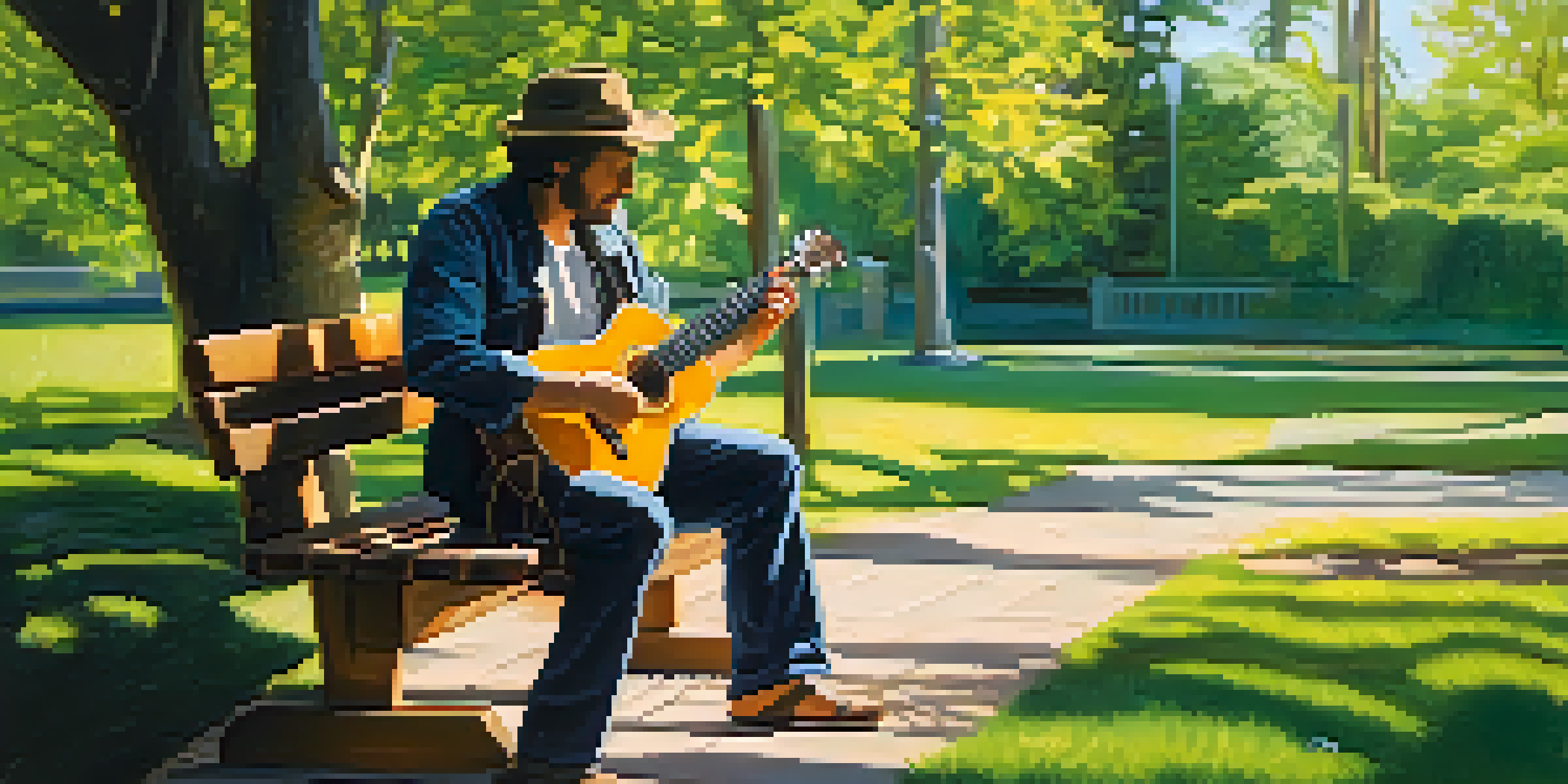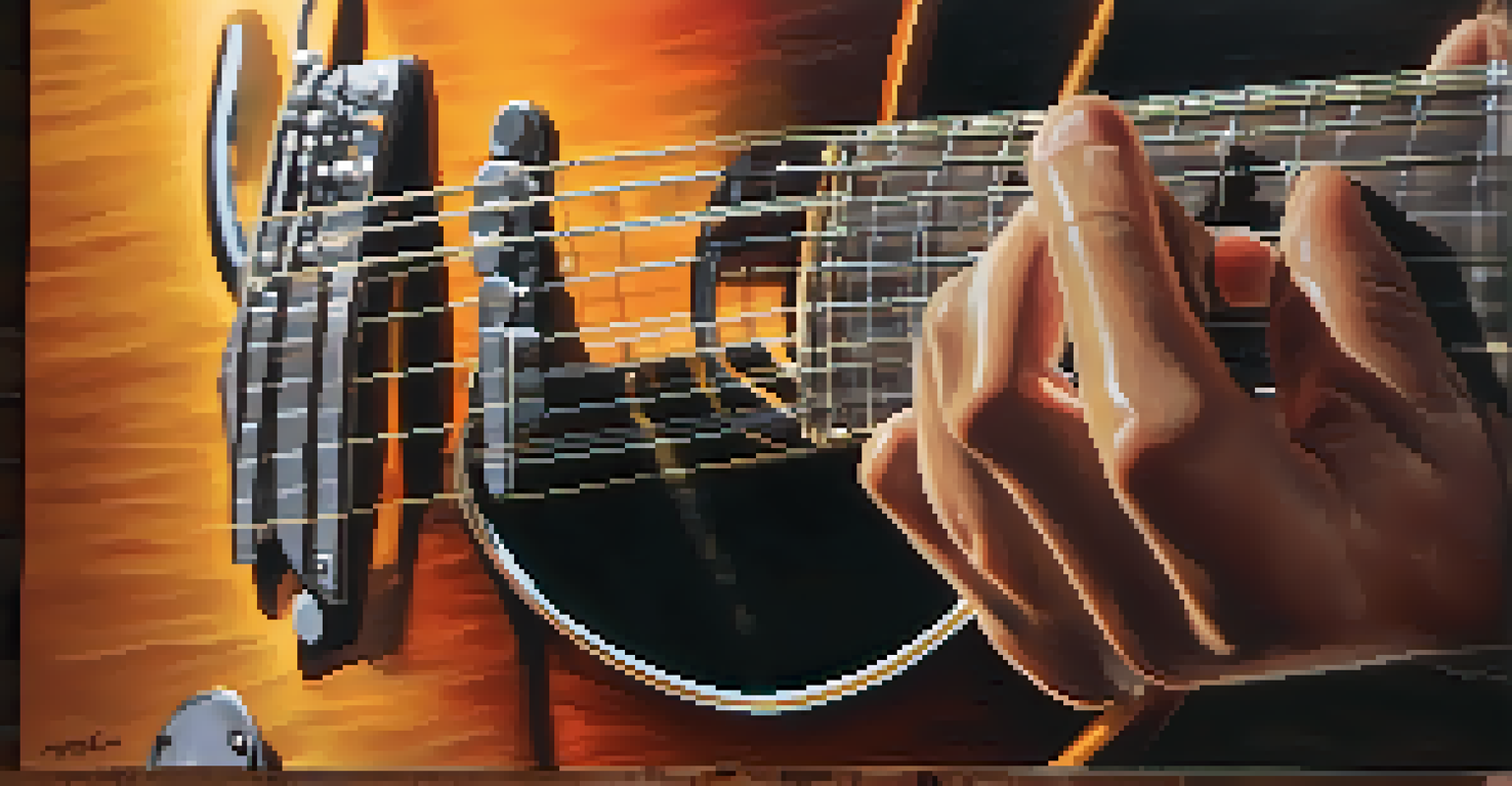Slide Guitar Techniques: Adding Expressiveness to Music

Understanding the Basics of Slide Guitar Playing
Slide guitar is a unique technique that involves using a slide, typically made of glass or metal, to glide over the strings. This creates a smooth, vocal-like quality in the music, allowing for pitch bending and expressive tones. Unlike traditional fretting, slide guitar requires a different approach to finger placement and pressure, which can be initially challenging but rewarding.
Music is the shorthand of emotion.
To get started, choose a slide that feels comfortable on your finger. Many players prefer a heavier slide for a more pronounced sound, while others opt for a lighter one for subtlety. Remember, the key is to find a slide that complements your playing style while also ensuring that your fingers maintain proper control over the instrument.
Related Resource
Practice is crucial in mastering slide guitar. Start with simple melodies or scales, focusing on clean transitions between notes. As you build your confidence, you can experiment with more complex techniques that add depth and emotion to your music.
Choosing the Right Guitar and Slide
The type of guitar you use can significantly affect your slide playing experience. While many players prefer electric guitars for their sustain and tonal versatility, acoustic guitars can also produce beautiful slide sounds, particularly in blues and folk music. Ultimately, choose a guitar that resonates with your style and the sound you're aiming to achieve.

When it comes to selecting a slide, consider the material, weight, and fit. Glass slides often produce a warm, smooth tone, while metal slides can give a brighter, sharper sound. Experimenting with different slides will help you discover which one enhances your unique voice as a musician.
Mastering Slide Guitar Techniques
Focus on essential techniques like finger placement and vibrato to achieve a clean and expressive sound.
Additionally, some players find that altering their guitar setup—like adjusting string height—can make slide playing more comfortable. A lower action may help you slide smoothly without excessive finger pressure, while a higher action can offer a more pronounced sound. Finding the right balance is essential for expressive playing.
Basic Techniques for Effective Slide Guitar Playing
To achieve a clean and expressive sound, mastering the basic slide techniques is vital. One fundamental skill is ensuring that the slide is placed directly over the fret, rather than between them, to avoid unwanted buzzing. This precision helps create a clear tone, allowing the music to shine.
The more you practice, the luckier you get.
Another important technique is controlling your vibrato with the slide. By subtly rocking your hand back and forth while maintaining contact with the string, you can produce rich, emotional nuances that resonate with listeners. This technique is particularly effective in genres like blues and country, where expressive playing is key.
Related Resource
Finally, don’t underestimate the power of dynamics. Varying your picking intensity and slide pressure can create a range of sounds, from soft, whisper-like notes to bold, powerful bursts. This dynamic range adds depth and character to your music, captivating your audience.
Exploring Advanced Slide Guitar Techniques
Once you've grasped the fundamentals, it's time to dive into advanced techniques that can elevate your slide guitar playing. One such technique is the use of harmonics, where you lightly touch the string while sliding to create a bell-like tone. This adds an ethereal quality to your music that can be enchanting.
Another advanced skill is incorporating double stops, where you play two strings simultaneously with the slide. This technique enriches your sound and allows for harmonies that can be incredibly satisfying. Experimenting with different combinations can lead to unique musical ideas.
Choosing the Right Gear Matters
Selecting the appropriate guitar and slide can significantly enhance your slide playing experience.
Finally, consider integrating techniques like palm muting or fingerpicking alongside your slide playing. These methods can add texture and contrast to your performance, making your music even more engaging and expressive. The key is to keep exploring and pushing your boundaries.
Incorporating Slide Guitar into Various Music Genres
Slide guitar isn’t just for blues; it can be infused into various genres, including rock, country, and even jazz. Each genre offers a unique context for slide playing, allowing you to adapt your techniques to suit the style. For instance, in rock music, slide can add an element of grit and power, particularly in solos.
In country music, slide guitar can evoke a sense of nostalgia and storytelling, often complementing the lyrical themes. The smooth transitions and expressive bends can make a simple melody feel deeply emotional. Understanding the genre you’re playing in can help you tailor your slide techniques to enhance the overall sound.
Related Resource
Jazz is another genre where slide guitar can shine, providing a way to explore complex chord progressions and improvisation. By incorporating slides into your solos, you can create unexpected twists that keep your audience engaged. The versatility of slide guitar truly knows no bounds!
Practicing Slide Guitar: Tips for Improvement
Like any musical skill, regular practice is essential for mastering slide guitar. Set aside time each day to focus on specific techniques, whether it’s working on scales, experimenting with new songs, or refining your vibrato. Gradually increase the complexity of your exercises as you become more comfortable.
Listening to slide guitar masters can also provide inspiration and insights into effective techniques. Artists like Duane Allman, Bonnie Raitt, and Derek Trucks offer a wealth of styles and approaches to learn from. Analyzing their work can uncover new ideas and enhance your own playing.
Emotional Connection through Music
Conveying emotion and vulnerability in your playing can create a powerful connection with your audience.
Finally, don’t be afraid to record yourself and listen back. This can help identify areas for improvement and track your progress over time. Celebrate your growth, and remember that every musician has their own journey—embrace yours!
Bringing Emotion and Expressiveness to Your Slide Playing
At the heart of slide guitar is the ability to convey emotion through sound. To achieve this, focus on how you interact with the instrument—think of your slide as an extension of your voice. The way you manipulate the slide can evoke joy, sadness, or any emotion in between, making your music relatable and impactful.
Consider incorporating lyrical phrasing into your slide guitar playing. Just as a singer uses breath and dynamics to tell a story, you can use your slide to create musical phrases that resonate with listeners. This connection to the audience is what makes music a powerful form of expression.

Lastly, allow yourself to be vulnerable in your playing. Sometimes, the most beautiful moments come from mistakes or unexpected sounds. Embracing imperfection can lead to unique musical expressions that make your slide guitar journey truly personal and memorable.